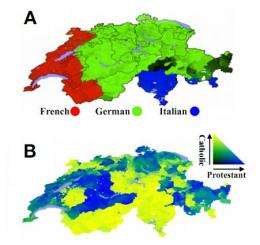October 13, 2011 report
Research group finds creating boundaries key to reducing ethnic violence

(PhysOrg.com) -- History is filled with examples of ethnic violence, the type that erupts when people with differing cultures attempt to live side by side. The Middle East comes to mind, as does Northern Ireland or Yugoslavia. What’s not so common are studies done that show what sorts of things actually work to prevent problems when people of dissimilar backgrounds live next door to one another. Thus, a new study done by Yaneer Bar-Yam and his team at the New England Complex Systems Institute, appears to be particularly relevant. He and his colleagues, describe in their paper on the preprint server arXiv, how a study they’ve done of the ethnically diverse country of Switzerland, shows that political and geographical boundaries have served to keep the peace between the different groups.
Switzerland, the very modern symbol of a peaceful country, might have gone another direction the team finds, were it not for the way the differing groups (French, German and Italian) and religions (Catholic and Protestant) have been physical grouped within the borders of the small country.
Those of German descent make up the largest group, taking up most of the north, central and eastern parts of the country while those with Italian backgrounds live predominately in the south; those of French descent have settled mainly in the west. Not surprisingly, those of the Catholic faith live predominately in the southern and middle parts of the country, due to the influx of those of Italian descent, while those of the Protestant faith live mainly in the rest of the country.
To find out how all these differing groups found a way to get along, the team looked at the geography of the country (mainly mountains and lakes) and how its regions are subdivided. In Switzerland, areas of the country are partitioned into what are known as cantons, which are similar to states in other countries except that each has much more autonomy than is usual. After careful study, the team found that the main reason the groups all manage to get along, is because they are separated from one another. Each canton is comprised of almost all the same types of people, essentially ruling themselves, thus, there is very little overlap. Other areas are separated by lakes or mountains. The end result is that people of differing cultures very seldom run into one another (except in the larger cites of course) and thus friction is averted. The one exception appears to be a little area north of Bern, where violence did erupt in the 1970’s. That problem was apparently fixed by simply redistricting the cantons in that area.
One problem with the study of course is that it doesn’t take into account the history of the land itself. The problems with India and Pakistan, for example, or with Israel and the rest of the Middle East aren’t likely to be solved by building better borders. But, nonetheless, the study does shed a rather bright light on the idea that simple separation can sometimes lead to peace. Not unlike how a schoolteacher might solve a problem between two quarreling youngsters.
More information: Good Fences: The Importance of Setting Boundaries for Peaceful Coexistence, arXiv:1110.1409v1 [physics.soc-ph] arXiv:1110.1409v1 [physics.soc-ph]
Abstract
We consider the conditions of peace and violence among ethnic groups, testing a theory designed to predict the locations of violence and interventions that can promote peace. Characterizing the model's success in predicting peace requires examples where peace prevails despite diversity. Switzerland is recognized as a country of peace, stability and prosperity. This is surprising because of its linguistic and religious diversity that in other parts of the world lead to conflict and violence. Here we analyze how peaceful stability is maintained. Our analysis shows that peace does not depend on integrated coexistence, but rather on well defined topographical and political boundaries separating groups. Mountains and lakes are an important part of the boundaries between sharply defined linguistic areas. Political canton and circle (sub-canton) boundaries often separate religious groups. Where such boundaries do not appear to be sufficient, we find that specific aspects of the population distribution either guarantee sufficient separation or sufficient mixing to inhibit intergroup violence according to the quantitative theory of conflict. In exactly one region, a porous mountain range does not adequately separate linguistic groups and violent conflict has led to the recent creation of the canton of Jura. Our analysis supports the hypothesis that violence between groups can be inhibited by physical and political boundaries. A similar analysis of the area of the former Yugoslavia shows that during widespread ethnic violence existing political boundaries did not coincide with the boundaries of distinct groups, but peace prevailed in specific areas where they did coincide. The success of peace in Switzerland may serve as a model to resolve conflict in other ethnically diverse countries and regions of the world.
© 2011 PhysOrg.com
















